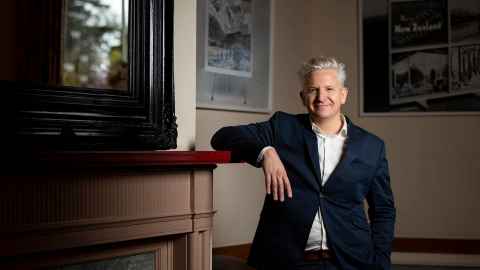Seeing our self-promotion in a new, sometimes awkward light
28 July 2020
An exhibition of photographs on show in Old Government House, University of Auckland, is a kind of ‘coming home’ for the artist curator, Emil McAvoy, who developed the exhibition as part of his Postgraduate Diploma of Fine Arts in 2010.

The exhibition, The National Basement, the work of Emil McAvoy, was also the subject of further research for his Masters of Fine Arts (2011-13) and beyond.
It features a suite of 17 digitally restored and re-printed archival photographs curated from the New Zealand Government’s National Publicity Studios (NPS).
The exhibition came of research he began after being awarded the Archives New Zealand 50th Anniversary Scholarship in 2009. The project involved sifting through 250,000 images from the below-ground storage facilities of Archives New Zealand in Wellington, which he came to light-heartedly refer to as “The National Basement”.
The photographs depict displays used to promote New Zealand tourism, trade and positive public relations. Most of the original material has been destroyed, but the photographs of these displays taken by the NPS, and which were not intended for publication, still remain as traces. These images have been “lovingly restored, made public and reframed in a new context,” says Emil.
The images prompt a playfully critical look at the ways in which New Zealand has officially and collectively promoted itself. They are not the kind of images that allow us to immerse ourselves in the beautiful scenery, but oblige us to step back, perhaps slightly to the side.
The exhibition includes a photograph of a suitcase into which can be packed a pop-up display of the nation’s best sides: its landscapes, houses on quarter-acre sections, its growing cities, geothermal power, and more.
The exhibition includes a photograph of a
suitcase into which can be packed a pop-up display of the nation’s best sides:
its landscapes, houses on quarter-acre sections, its growing cities, geothermal
power, and more.
There are also moments of awkward postcolonial irony. A photograph of a pamphlet holder in the shape of a wharenui was photographed resting on a sign in the NPS workshop emblazoned with the word DANGER.
“In a contemporary context, this unintentional contrast speaks to longstanding Pakeha appropriation and commercialisation of Maori taonga and culture,” says Emil.
The original negative features a smaller rectangle inscribed in pen to indicate the intended crop marks for a print to be made, and where this sign is cropped out. Emil has printed the negative full-frame to emphasise the colonial dynamics at play – and their inherent dangers – in the construction of national identity evident in New Zealand’s early tourism promotion.
The National Basement was part of a larger survey exhibition at City Gallery Wellington in 2018 called This Is New Zealand, curated by Robert Leonard and Aaron Lister, in which a number of artists explored how our country has represented itself and what those representations have included and excluded.
In the catalogue that accompanied the exhibition, curator Aaron Lister said: “By focusing on the mechanics of display McAvoy lets the NPS’s problematic politics reveal themselves, while offering us an alternative ‘tiki tour’ through a New Zealand that never really was. He doesn’t return these images as things to be laughed at or longed for. Part of his point is that this is the very New Zealand people talk about when nostalgically pining for the good old days…”
That the exhibition is displayed in Old Government House provides an idiosyncratic backdrop, says Emil. “This site played an important part in our government until 1865, which contributes another dimension of meaning to the exhibition. There is soft propaganda evident in these images, intended to sit a bit awkwardly in this historic building.”
The National Basement is now on display at Old Government House (open 8am-7pm Monday to Friday) and runs until 22 September 2020.
Media contact
Margo White I Media adviser
DDI 09 923 5504
Mob 021 926 408
Email margo.white@auckland.ac.nz